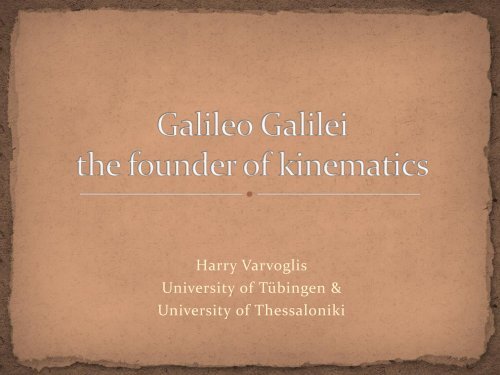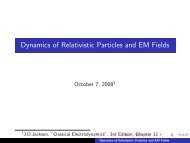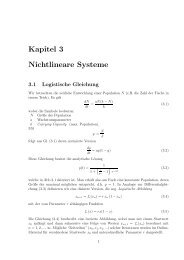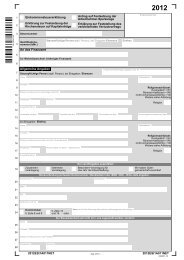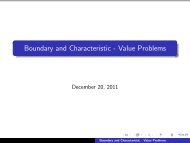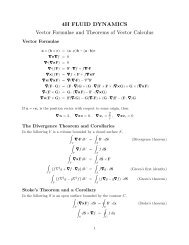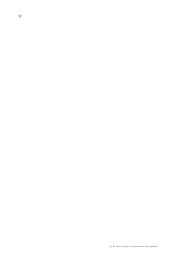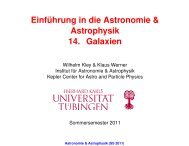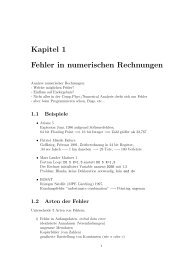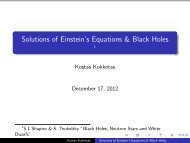Kinematics - Galileo
Kinematics - Galileo
Kinematics - Galileo
Create successful ePaper yourself
Turn your PDF publications into a flip-book with our unique Google optimized e-Paper software.
Harry Varvoglis<br />
University of Tübingen &<br />
University of Thessaloniki
• Founder of modern Science<br />
• The first of the six children of Vincenzo Galilei,<br />
musician, and of Giulia Ammannati<br />
• Born in Pisa<br />
• At age 8 his family moved to Florence (80 km<br />
away…)<br />
• <strong>Galileo</strong> attended school in a monastery near<br />
Florence and was thinking to follow an<br />
ecclesiastical career, but...<br />
2
• He entered the School of<br />
Medicine of the University<br />
of Pisa.<br />
• But, finally, he got a Degree<br />
in Mathematics.<br />
• Salary of a professor: in<br />
Medicine 2.000 scudi/year<br />
(1 scudo ≈ € 200), in<br />
Mathematics 80<br />
scudi/year!<br />
• In 1589 he was appointed<br />
professor of Mathematics<br />
in the University of Pisa.<br />
• It is there that the<br />
foundations of his later<br />
scientific career were set. 3
• The oscillations of the<br />
chandelier in the<br />
Duomo (i.e. Cathedral)<br />
of Pisa gave him the<br />
idea that:<br />
• The oscillations of a<br />
pendulum (today we<br />
know only those of<br />
small amplitude) are<br />
isochronous.<br />
• Huygens, based on this<br />
observation, built later<br />
the first pendulum<br />
clock. 4
• Professor of Mathematics in the University<br />
of Padova, the second largest city in the<br />
Republic of Venice.<br />
• Construction of scientific instruments<br />
(geometrical and military compass)<br />
• Experiments with inclined planes<br />
5
• Analog computer for<br />
solving numerical and<br />
geometrical problems<br />
(e.g. square and cubic<br />
roots!)<br />
• Topographical works<br />
• Note how he describes<br />
himself: Nobile<br />
Fiorentino, Lettore<br />
delle Mathematiche<br />
6
• Contrary to the<br />
tradition, <strong>Galileo</strong> never<br />
performed the<br />
experiment of letting<br />
several bodies of<br />
different weight to fall<br />
from the top of the<br />
inclined Pisa Tower.<br />
• Instead, he performed<br />
experiments with<br />
inclined planes, where<br />
measuring time<br />
intervals is easier.<br />
• He says that he<br />
measured time<br />
intervals by counting<br />
his heartbeat, but more<br />
probably he did it by<br />
singing, as he had<br />
learned from his 7<br />
father!
From Deutsches Museum<br />
8
• The distances<br />
covered are<br />
proportional to<br />
the squares of<br />
the<br />
corresponding<br />
time intervals,<br />
From Deutsches Museum<br />
S = ½at 2<br />
• The inclination<br />
is small, in<br />
order to make<br />
the<br />
measurement of<br />
time easier.<br />
9
• According to the<br />
Aristotelian theory (top)<br />
heavier bodies fall faster<br />
(Fig. 1).<br />
• But this leads to a<br />
contradiction (we said<br />
that already!): If we tie a<br />
heavy and a light body,<br />
the two will fall faster<br />
(Fig. 2) or slower (Fig. 3)<br />
than the heavier?<br />
• <strong>Galileo</strong> solved the<br />
problem, by showing<br />
experimentally that all<br />
bodies fall with the same<br />
acceleration (bottom).<br />
10
(From <strong>Galileo</strong>’s<br />
notes)<br />
11
• Geometrical methods for solving problems of<br />
Calculus:<br />
S = vt, S = ½γt 2 as the area of orthogonal triangles<br />
• Books: Mechanics (1600), Discourses and<br />
Mathematical Demonstrations Relating to Two New<br />
Sciences (1638)<br />
• Co-ordinate systems (perfected little later by<br />
Descartes)<br />
• Galilean transformations (we will come back to that)<br />
x' = x – v 0 t, v' = v – v 0<br />
12
• <strong>Galileo</strong> presented his<br />
first telescope to the<br />
Dogue of Venice on<br />
August 25, 1609.<br />
• He published his<br />
theory of making<br />
telescopes in his book<br />
Sidereus Nuncius<br />
(Starry Messenger),<br />
which appeared in<br />
1610.<br />
14
• The first page of the<br />
book, which was<br />
published by a printing<br />
house in Venice.<br />
• Note, a change in how<br />
he refers to himself:<br />
Patritio Florentino,<br />
Patavini (Paduan)<br />
Gymnasii Publico<br />
Mathematico.<br />
15
• Mountains and craters<br />
on the surface of the<br />
Moon imply that it is a<br />
heavenly body like<br />
Earth, and not a<br />
“perfect sphere”, as<br />
believed by<br />
Aristotelian<br />
philosophers.<br />
16
• Observations indicated,<br />
beyond any doubt, that<br />
Venus is revolving around<br />
the Sun (left: Ptolemy’s<br />
theory of epicycles, right:<br />
Copernicus’ heliocentric<br />
theory).<br />
• Heracleides from Pontos<br />
(from Black Sea, 380-310<br />
BC) had suggested the<br />
“intermediate” idea that<br />
Mercury and Venus are<br />
revolving around the Sun,<br />
but the rest of the planets<br />
(Sun included) are<br />
revolving around the<br />
Earth.<br />
17
The struckout text,<br />
appearing in the<br />
manuscript<br />
of the book<br />
De Revolutionibus,<br />
was not included<br />
in the printed version.<br />
18
• <strong>Galileo</strong>’s manuscript<br />
(top) and pages from<br />
Sidereus Nuncius<br />
(bottom).<br />
• The systematical<br />
recording of <strong>Galileo</strong>’s<br />
observations shows<br />
that the “starlets” are,<br />
in reality, satellites of<br />
Jupiter.<br />
• Therefore Jupiter is a<br />
miniature of our Solar<br />
System. 19
• <strong>Galileo</strong> suggested the use of the position of<br />
Jupiter’s satellites for the measurement of<br />
“absolute” time and, therefore, for the calculation<br />
of longitudes.<br />
• The difficulty of observations from a ship made<br />
this method not practical.<br />
• The problem was solved after the invention of<br />
marine chronometers by John Harrison (spring<br />
balance & grasshopper escapement).<br />
20
• Invitation by the Great Duke of Tuscan,<br />
Cosimo II of Medici<br />
• Big salary, freedom in residence and<br />
teaching<br />
• Return to his “fatherland”<br />
• But return to the region of dominance of the<br />
Pope.<br />
21
• 1611: <strong>Galileo</strong> visits Rome.<br />
• His work is recognized and he<br />
becomes a member of the first<br />
scientific society, Academia dei<br />
Lincei.<br />
• He organizes astronomical<br />
observations with his telescope<br />
for the Jesuit monks in Rome.<br />
• Reaction: Why look through this<br />
imperfect instrument, once we<br />
know the truth from Aristotle<br />
and the Bible? (Cesare<br />
Cremonini, Paduan professor<br />
Giulio Libri, Florentian<br />
philosopher).<br />
22
• God is perfect, and all of God’s creation is perfect.<br />
Man is imperfect, and therefore his inventions are<br />
imperfect. Why should we use an imperfect<br />
invention, like <strong>Galileo</strong>’s telescope, to see God’s<br />
perfect creation? Wouldn’t that corrupt God’s<br />
creation?<br />
• Where is the picture we see through the telescope?<br />
In the real world or inside the telescope?<br />
23
• The solar surface has<br />
spots, which change<br />
place as the Sun<br />
rotates.<br />
• Therefore, not only the<br />
Sun is not “perfect”, as<br />
declared by the<br />
Aristotelian<br />
philosophy, but it<br />
rotates, as well, about<br />
an axis.<br />
24
• First warning, not to teach the heliocentric system.<br />
• In order to “fight” Kepler’s book Astronomia Nova<br />
and <strong>Galileo</strong>’s publications…<br />
• The church adds the books by Copernicus, Kepler and<br />
some of <strong>Galileo</strong>’s “letters” in the Index Librorum<br />
Prohibitorum (1559-1948).<br />
• They were withdrawn only in 1835!<br />
25
• It started with <strong>Galileo</strong> disagreeing with the Jesuit monk<br />
Orazzio Grassi, about the nature and the orbit of the comet<br />
of 1619. Grassi insisted that the comet was closer than the<br />
Moon (according to Aristotelian views), <strong>Galileo</strong> calculated<br />
that it was further away.<br />
• There was an “escalation” in exchanging arguments from<br />
both sides (books and pamphlets published under a “nom<br />
de plume” or written by “followers” of each side).<br />
• The debate reached a climax with the publication of the<br />
book Il Saggiatore (assayer=tester, a kind of stone used to<br />
measure content in gold of an alloy ), written in Italian and<br />
not in Latin, where <strong>Galileo</strong> brings forth all arguments for<br />
the heliocentric theory and ridicules openly Grassi and his<br />
other opponents.<br />
26
Academico Lincei<br />
Nobile Fiorentino<br />
Filosofo e Matematico Primario<br />
Del Serenissimo Gran Duca<br />
di Toscana<br />
27
• Discussion with Pope Urbanus VIII<br />
(cardinal Maffeo Barberini , native of<br />
Florence and <strong>Galileo</strong>’s friend).<br />
• Papal “advice” to refer to the heliocentric<br />
system only as a “mathematical hypothesis”.<br />
• Within this framework, he gets the<br />
“imprimatur” (=permit to publish) his next<br />
book.<br />
28
• Matematico Sopraordinario (Extraordinaire)<br />
• dello Studio di Pisa<br />
• e Filosofo e Matematico<br />
• Del Serenissimo Gran Duca di Toscana<br />
• (he was not any more “Academico Linceo…)<br />
30
• Salviati (“heliocentric"), from the name of Filippo<br />
Salviati, <strong>Galileo</strong>’s friend.<br />
• Sagredo (“neutral"), from the name of<br />
Giovanfransesco Sagredo, <strong>Galileo</strong>’s friend.<br />
• Simplicio (“Aristotelian"), from the name of the<br />
Greek Aristotelian philosopher of the 6 th century<br />
AD Simplicius, but a play of words, as well<br />
(=naïve).<br />
31
• Inside cover of the first<br />
edition of Dialogo<br />
• <strong>Galileo</strong> had got the<br />
imprimatur from the<br />
Inquisition of Florence.<br />
• But the Pope had a<br />
different opinion…<br />
32
• <strong>Galileo</strong> is charged by the<br />
Jesuits for heretic<br />
teaching.<br />
• The permit of<br />
publication of his book<br />
is revoked.<br />
• He is tried in 1633 by the<br />
Inquisition and he is<br />
shown the instruments<br />
of torture.<br />
• He is obligated to<br />
renounce his ideas in a<br />
monastery in Rome, in<br />
June 22, 1633<br />
• He was condemned to<br />
home detention<br />
(successively in Rome-<br />
Sienna-Arcetri).<br />
33
• Thermometer based on the<br />
expansion of gases .<br />
• Basic target: measurement of<br />
the temperature of patients.<br />
• Inaccurate, due to the<br />
variability of the atmospheric<br />
pressure.<br />
• Torricelli, however, removed<br />
completely the air and turned<br />
it into the well known<br />
barometer!<br />
36
• Motion at constant<br />
acceleration<br />
• Galilean<br />
transformations<br />
• Independence of<br />
motions<br />
• Geometrical proofs<br />
• Inertia principle (but<br />
see reference to John<br />
Philoponus in De motu<br />
antiquitora, Pisa, ~1590)<br />
37


